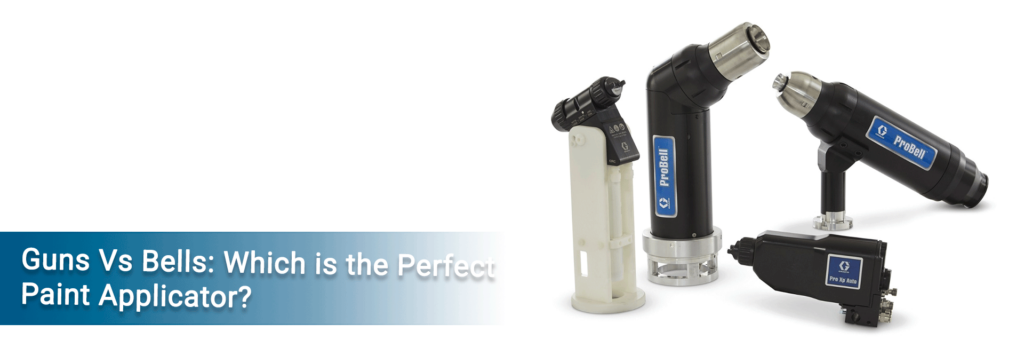Manufacturers and finishers have a plethora of techniques at their disposal for applying paint or finish to their products. Spraying is common in industry because it’s versatile and cost-effective. Two popular methods are air spray guns and rotary bell atomizers. They work differently and are used with robots for automated finishing. Different paint applicators have different performance features, which vary according to the brand, model, and design.
Importance of Paint Application System
The main aim of the Paint Application System is to create a smooth and uniform coating on the object. This coating serves various purposes:
- Enhancing the appearance of the part.
- Providing protection against scratches, rust, and UV damage.
- Improving the part’s performance in its final use, such as making it more resistant to moisture or reducing drag in vehicles like cars, planes, or boats.
In spraying, the coating is turned into tiny droplets and sprayed onto the part’s surface. These droplets congregate and spread to create a thin coating. Spray guns and bells are the primary tools used for this.
Recommended Blog – Benefits Of Paint Circulation System
Paint applicators- Guns and Rotatory Bells
In most industries, air atomized spray guns are popular, but in the OEM auto and truck industry, rotary bell atomizers rule the scene. Let’s look into these two types of spray applicators–
Spray Guns
Air-atomized spraying involves pressurizing paint and mixing it with compressed air in conventional spray guns. The compressed air breaks the liquid into droplets, creating a spray. Conventional spray guns can handle a variety of coatings, including catalyzed, high-solids, waterborne coatings, and traditional finishes.
The size and shape of the hole, along with how fast the fluid flows through it, control this process. Other elements that impact the spray include the fluid’s thickness, the pressure behind it, and the size and form of the flow route. The spray pattern is likewise controlled and directed by the shaping air. Since the fluid stream is already moving fast when it’s split, the particles from Air assisted guns move faster towards the part compared to those from bells.
If you want to know more about paint guns, checkout our dedicated blog here
Rotatory Bells
On the rotatory bell, the spinning cup makes the fluid move by adding force sideways to the direction of the stream as it nears the cup’s edge. The size of the particles mainly depends on
- How the cup of rotatory bells is designed
- How fast the coating flows
- How fast the cup spins
- How quickly fluid gets to the cup’s edge
This means most of the energy given to the particle goes sideways from the bell and towards the part. It would just stay around adjacent to the portion, with very little fluid reaching the surface, if there was no means to direct the mist. Then, the spray pattern is shaped and directed towards the part using shaping air.
Difference Between Paint Guns and Bells
Since both Spray applicators have the same purpose, it’s clear they share many similarities. Both turn the coating into a mist, forming a fan pattern that covers the target surface. They both use compressed air to shape the fan pattern.
Also, they can both be used in electrostatic applications, where the paint is charged and attracted to the grounded part which leads to reduced overspray and improved transfer efficiency. But there are differences between Paint guns and bells as well. Let’s look closely at factors like how they’re used, how much maintenance they need, the pattern they spray, how precise they are, how much they cost, and the benefits they offer in various industries.
| Aspect | Guns | Bells |
| Size and Weight | Typically smaller and lighter weight | Larger and heavier |
| Operator Fatigue | Provide greater control with less stress and fatigue | Generally limited to robotic or automated applications |
| Maintenance | Generally require less maintenance | More complex with lots of moving parts, requiring more maintenance |
| Fluid Viscosity and Pressure | Better suited for higher viscosity, higher pressure applications | Used with lower viscosity fluids at lower pressure |
| Spray Pattern | Oval-shaped patterns | Circular-shaped patterns |
| Atomization Process | Atomize fluid by air impingement at the nozzle air caps | Break up paint into droplets by applying centrifugal forces at the edge of spinning disks |
| Surface Finish | May produce less uniform distribution of particles, potentially affecting smoothness of finish | Typically produce smaller-sized array of paint particles, contributing to overall smoothness of surface finish |
| Precision and Robustness | Generally less precise and robust | More robust and precise, suitable for extended run times without manual cleaning |
| Investment | Typically lower investment | Typically carry a higher investment, especially for specialized applications such as automotive industry |
| Automation Features | Not designed exclusively for automation, may lack features like automatic spray head rinsing and integrated fluid return dump valves | Designed exclusively for automation, offering features like automatic spray head rinsing and integrated fluid return dump valves |
| Paint Coatings Compatibility | Coatings formulated for manual hand-held air atomizers are typically used | Adjustments to viscosity or reducing solvent might be needed for optimal results with rotary bells |
| Robot Path Programming | Requires specific wrist positioning to manage oval-shaped spray patterns | Offers more freedom of movement for robots due to symmetrical plume, simplifying path programming and avoiding singularity issues |
| Industry Usage | Widely used across various industries | Almost exclusively used in the automotive industry |
| Advantages in Auto Industry | Offers advantages in terms of paint savings, reduced cycle time, maintainability, and surface finish quality | Provides smoother appearance for clearcoat finishes, reducing solvent pop defects |
Conclusion
Both air guns and rotary bell atomizers have their own advantages and disadvantages. In several sectors, air guns—especially HVLP models—are considered standard atomizers for low-pressure painting. Rotating bell atomizers, on the other hand, can significantly improve robotic painting. In the end, it’s essential to do an in-depth evaluation of both technologies for your specific robotic paint application system.
FAQs
The main advantage is its versatility, allowing skilled operators to coat almost any object and apply coatings with controlled viscosity, flow, and drying rate.
Conventional spray guns with organic-solvent-thinned paints produce overspray and solvent evaporation, requiring large volumes of make-up air and high exhaust rates to protect workers.
High-viscosity, high-solids coatings (65-percent-volume solids and higher) can be atomized and electrostatically applied using high-rotational-speed disks and bells.
Rotating bells can apply coatings in either fixed or reciprocating modes and can also be used manually or attached to robot arms.



